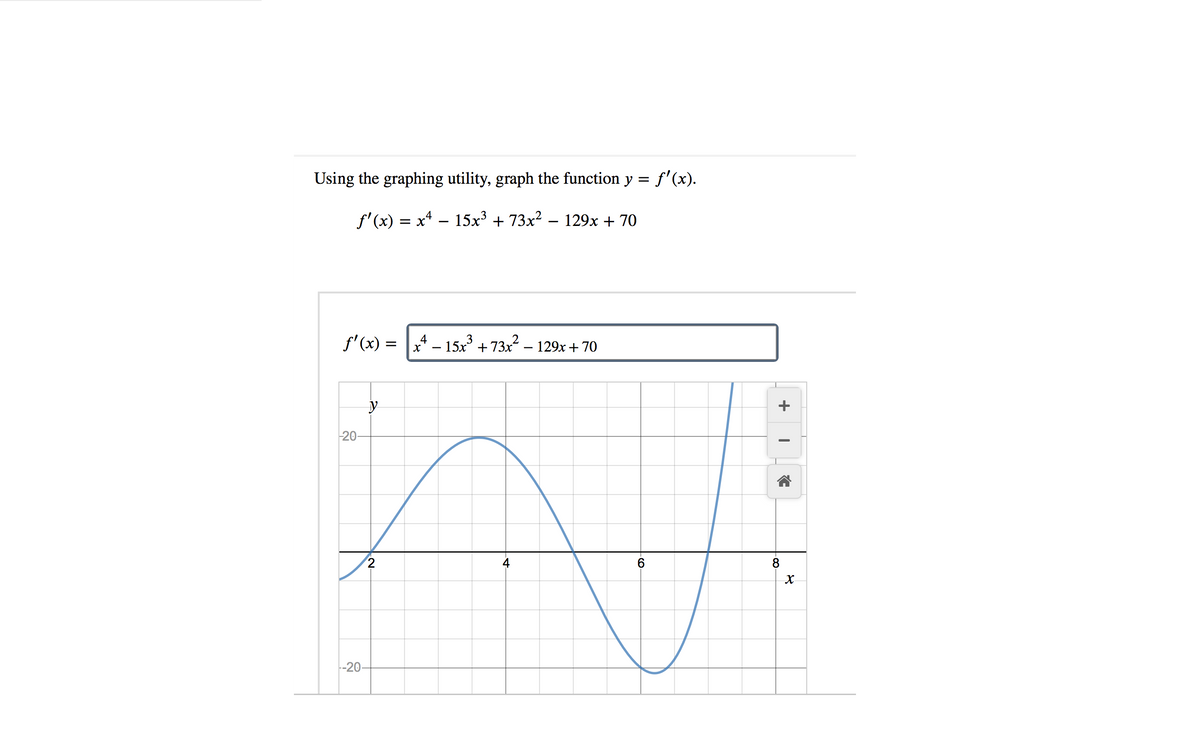Use the graph to find the point(s) of inflection of f. (Give your answer as a comma-separated list of points in the form (*, *). Use decimal notation. Give your numbers to three decimal places. Enter DNE if the function has no inflection points.) inflection point(s): Use the graph to determine the interval(s) on which the function ƒ is concave down. (Give your answer as an interval in the form (*, *). Use the symbol ∞ for infinity, u for combining intervals, and an appropriate type of parenthesis "(",")", "[",")]" depending on whether the interval is open or closed. Enter Ø if the interval is empty. Use decimal notation. Give your numbers to three decimal places.) interval(s):
Use the graph to find the point(s) of inflection of f. (Give your answer as a comma-separated list of points in the form (*, *). Use decimal notation. Give your numbers to three decimal places. Enter DNE if the function has no inflection points.) inflection point(s): Use the graph to determine the interval(s) on which the function ƒ is concave down. (Give your answer as an interval in the form (*, *). Use the symbol ∞ for infinity, u for combining intervals, and an appropriate type of parenthesis "(",")", "[",")]" depending on whether the interval is open or closed. Enter Ø if the interval is empty. Use decimal notation. Give your numbers to three decimal places.) interval(s):
Trigonometry (MindTap Course List)
10th Edition
ISBN:9781337278461
Author:Ron Larson
Publisher:Ron Larson
Chapter1: Trigonometry
Section1.7: Inverse Trigonometric Functions
Problem 2ECP
Related questions
Question

Transcribed Image Text:Using the graphing utility, graph the function y = f'(x).
f'(x) = x4 – 15x³ + 73x? – 129x + 70
f' (x) =
4 – 15x + 73x² – 129x + 70
20
2
8
-20
+
![Use the graph to find the point(s) of inflection of f.
(Give your answer as a comma-separated list of points in the form (*, *). Use decimal notation. Give your numbers to three
decimal places. Enter DNE if the function has no inflection points.)
inflection point(s):
Use the graph to determine the interval(s) on which the function f is concave down.
(Give your answer as an interval in the form (*, *). Use the symbol co for infinity, U for combining intervals, and an
appropriate type of parenthesis "(",")", "[","]" depending on whether the interval is open or closed. Enter Ø if the interval is
empty. Use decimal notation. Give your numbers to three decimal places.)
interval(s):](/v2/_next/image?url=https%3A%2F%2Fcontent.bartleby.com%2Fqna-images%2Fquestion%2F53439359-1ad8-43a2-9307-2c193a83e82b%2F104bdedb-359e-4879-bcf0-0a3fe7bbfb41%2F1qit3w_processed.png&w=3840&q=75)
Transcribed Image Text:Use the graph to find the point(s) of inflection of f.
(Give your answer as a comma-separated list of points in the form (*, *). Use decimal notation. Give your numbers to three
decimal places. Enter DNE if the function has no inflection points.)
inflection point(s):
Use the graph to determine the interval(s) on which the function f is concave down.
(Give your answer as an interval in the form (*, *). Use the symbol co for infinity, U for combining intervals, and an
appropriate type of parenthesis "(",")", "[","]" depending on whether the interval is open or closed. Enter Ø if the interval is
empty. Use decimal notation. Give your numbers to three decimal places.)
interval(s):
Expert Solution
This question has been solved!
Explore an expertly crafted, step-by-step solution for a thorough understanding of key concepts.
This is a popular solution!
Trending now
This is a popular solution!
Step by step
Solved in 2 steps

Knowledge Booster
Learn more about
Need a deep-dive on the concept behind this application? Look no further. Learn more about this topic, advanced-math and related others by exploring similar questions and additional content below.Recommended textbooks for you

Trigonometry (MindTap Course List)
Trigonometry
ISBN:
9781337278461
Author:
Ron Larson
Publisher:
Cengage Learning

Algebra & Trigonometry with Analytic Geometry
Algebra
ISBN:
9781133382119
Author:
Swokowski
Publisher:
Cengage

College Algebra (MindTap Course List)
Algebra
ISBN:
9781305652231
Author:
R. David Gustafson, Jeff Hughes
Publisher:
Cengage Learning

Trigonometry (MindTap Course List)
Trigonometry
ISBN:
9781337278461
Author:
Ron Larson
Publisher:
Cengage Learning

Algebra & Trigonometry with Analytic Geometry
Algebra
ISBN:
9781133382119
Author:
Swokowski
Publisher:
Cengage

College Algebra (MindTap Course List)
Algebra
ISBN:
9781305652231
Author:
R. David Gustafson, Jeff Hughes
Publisher:
Cengage Learning